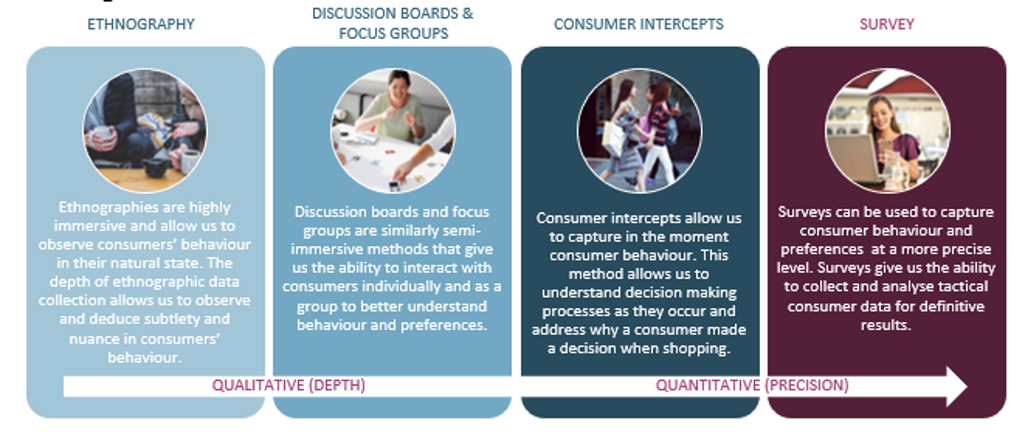One of the biggest challenges that can make or break consumer research is choosing the right method for data collection. Methods for researching consumers can be generally divided into qualitative and quantitative, and within that, exists a range of approaches from exploratory mobile ethnographies to tactical in-person surveys.

What do consumers think of our brand? How do consumers shop for our products? Who are my target consumers? These are all common business questions that can be answered with data from consumers. But before selecting a method for collecting data to answer those questions, consider these five common mistakes.
1. Having unspecified research objectives – Choosing a methodology before understanding the key research questions or goals is the number one mistake made in consumer research. This can lead to confusion on what kind of data should be collected and what the analysis should look like. What do we need to learn from consumers and what is our end goal? Rather than leading with the methodology, it is critical to identify the objectives and any potential hypotheses first.
In short, some research questions lend themselves to one methodology over another, but everything starts and ends with having clear and measurable research objectives that will drive that decision.
2. Putting the methodology ahead of the business question – Even with clear research objectives, it is easy to become distracted by shiny, new methodologies. Consider the research objective of trying to understand what “healthy” means when consumers are shopping for food. In-store eye tracking may be a cutting-edge technology and seem to lead to great insights about consumer buying habits, but it does not provide the same nuance and context as more traditional (and less sexy) qualitative research. Avoid overcomplicating a study or research question that might be conducted more efficiently with a simpler approach.
3. Forgetting to identify the target respondent ahead of time – Not taking the target respondents into consideration when choosing a method can lead to poor data quality. Some studies might have target consumers who are harder to reach or focus on a very narrow segment of the population. Others may be asking consumers sensitive questions that need a self-administered method. For example, respondents are more willing to be open and honest in discussing their smoking habits through an online survey vs an in-person survey where they are more likely to underreport their usage face-to-face. Take consideration of the difficulty of reaching your target respondents or the difficulty of the question being asked of them when deciding on a method.
4. Asking consumer questions that don’t match the method – A mistake that can occur either in the design or during the research phase is choosing a methodology that doesn't work with the specific types of questions we want to ask of respondents. Only asking close-ended questions or questions that can be answered in a word or two in a discussion board is not productive. And the reverse is true of asking too many open-end questions in an online survey, where questions should be shorter with the objective of quantifying measures that have already been determined.
Ask whether the questions you need to be answered to reach your objectives are more open or close-ended and let that determine which method to use.
5. Deciding on a type of analysis without the method in mind – Assuming that a specific kind of analysis can be done regardless of methodology (or assuming that quantitative analysis is always better) compromises the ability to gather strong insights. Qualitative methods use more observational approaches, often with open and flexible questions that are mined to build hypotheses. Quantitative methods are driven by logic and facts, with the intent to test a theory or hypothesis. The kind of data you collect will determine the analysis you can do, and the type of data you collect will be determined by the appropriate method selected.
In short, when deciding on the right methodology it is always best to work backward. Rather than coming to the table with a set method or specific statistical test, consider your research objectives first. Ask yourself, what is your end objective or what kind of analysis do I need to complete in the end? This will guide you to the right method, the right data, and ultimately the right kind of analysis and insights.
To answer our client’s critical business questions, Euromonitor International designs executes and analyses surveys and other consumer insights methods as part of our global research products. These surveys enable Euromonitor International to integrate consumer perspectives and context alongside the company’s industry-leading market data, providing tactical, actionable and quantifiable insights with extensive population coverage. Read more about our approach here.
